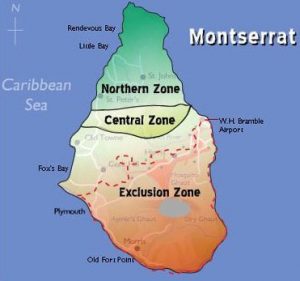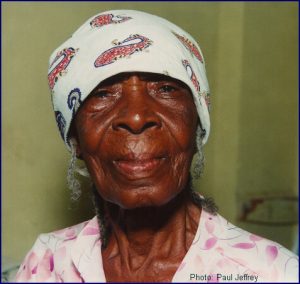
Montserrat Map with Exclusion Zone http://www.bbc.co.uk
In August 1995 elderly residents in the southern part of the island were relocated north as a precautionary measure in response to phreatic volcanic activity. Younger residents in the south followed later that month. By January, most residents were allowed to return to their homes. However, in April 1996 they were forced to move yet again because of increased activity. Evacuation soon became a ritual affair. Residents, and senior citizens in particular, soon resigned to the fact that an evacuation could happen at any time.
Reverend Joan Meade, pastor of the Leeward Islands District of the Methodist Church in the Caribbean and the Americas, comments on the state of Montserrat’s senior citizens after the pyroclastic activity: “Every so often the stress level rises and some of the ailing elderly decide not to hang around here anymore. Sometimes it happens when people start making plans to take them off the island. They prefer to die at home” (Moore 1997).
Before the 19 deaths on June 25, residents wanted to return to their evacuated homes as soon as it was safe. After the events of that day, most chose to leave, primarily to Great Britain, the United States, Canada, Antigua, and other Caribbean islands. Rev. Meade has been active in helping many of the island’s elderly residents relocate abroad. She assisted in coordinating travel arrangements with relatives, filing for passports, and helping with paperwork. Despite her intense effort, the Reverend understands that some of the residents must stay on the island even if it is not in their best interest to do so (Moore 1997).
“Some people still cannot travel because they cannot afford it” -Reverend Meade

http://www.gbgm-umc.org/response/volcano.htm
For some Montserratians, evacuation meant living with friends and relatives in the north. For others, it meant buying or constructing a home north of the exclusion zone. This was difficult because the island’s population was concentrated in the south, so housing in the north was scarce. Still others chose, or were forced (by individual circumstances) to leave Montserrat and start over abroad (See migration for more details). For many Montserratians, emergency shelters became their new homes for weeks, months, or years at a time. According to Polly Pattullo, author of Fire from the Mountain, “the shelters were inadequate and often squalid” (Pattullo 91).
Some attribute the deaths of June 25th, 1997, to the inadequacy of the shelters. Those who died had either returned home from the shelters or flat-out refused to move into them. Some Montserratians had publicly admitted that they would rather die than live in the shelters(Pattullo 91, 92).
As difficult as these living conditions must have been for every relocated person, it was especially hard on the elderly, many of whom required assistance with living. The high life expectancy in Montserrat means that many are living to ages where physical ailments become an everyday fact of life. It was difficult for a senior citizen to hold on to their sense of dignity when living in public situations, such as the shelters. Rooms were often very hot during the day, not ventilated properly, crowded, and noisy. Hundreds of people might share only a few toilets. In situations such as this, the elderly could no longer hide physical problems such as incontinence
(Pattullo 99).
Although every resident was affected by the evacuation in one way or another, the burden often was not uniformly distributed among the demographics. “The rich as well as the poor lost their homes, although it tended to be the poor and the elderly who stayed long-term in the shelters” (Pattullo 93).
Return to Aging in Montserrat page